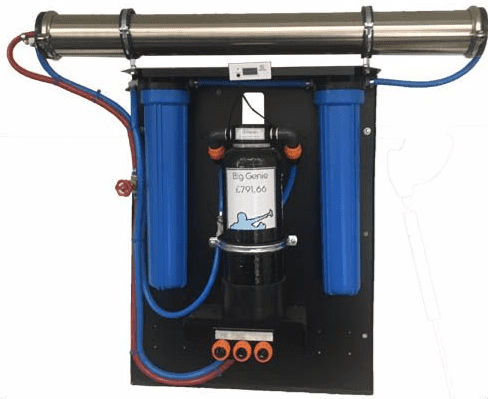Hi all, I am in the market to buy an RO system to make my own water as I currently use Spotless Water to fill my 500L tank.
I don't mind spending the money on something that will be worth it in the long run and will last or make life easier. I will need to fill up to 500L each day after work. I have been looking at the 4040 vs 4021 and HF4 vs HF5. I live in the West Midlands and TDS is currently around 140 but I'm sure was higher before when I first moved into the house (used to live in a flat).
My pressure is just over 50 PSI.
My understanding is the 4040 vs 4021 is just related to the size of the membrane the amount of water it can produce and potentially the speed at which the water can be made. with 50PSI I was leaning towards a HF5 membrane but having just called and spoken to the cleaning warehouse in Willenhall he said that the manufacturers recommend 100PSI for HF4 and 80PSI for HF5 membranes. So you will void the warranty if using less pressure. I was worried about less pressure causing the life span of the membrane to be reduced and he said it doesn't affect it too much but I've read otherwise. He said HF4 is cheaper than HF5 and because I'd have less than the pressure of both of the recommended values of the manufacturer's id be better off going the HF4 route and putting any saving towards a booster pump..
What do you think? Ideally, i'd go without a booster pump as I see they're a bit pricey but if needed, that's fine. Also what about features such as flushing the membranes? Can that be done manually on all of them?
Been looking at

 www.thecleaningwarehouse.co.uk
www.thecleaningwarehouse.co.uk
I like this one cause it will bolt to the frame I have as it's from the same place but not sure the guy has given me sound advice as other sites such as xline say some of their systems need 60 PSI else RO membrane could become damaged for example this one 2,000 GPD Static Manual Pure Water R/O System - Wall Mounted
Is it better to take pure from RO to tank and then DI to pole or would you recommend that I RO pure into DI then to tank and then just deliver to pole?
Thanks in advance for your help
Aaron
I don't mind spending the money on something that will be worth it in the long run and will last or make life easier. I will need to fill up to 500L each day after work. I have been looking at the 4040 vs 4021 and HF4 vs HF5. I live in the West Midlands and TDS is currently around 140 but I'm sure was higher before when I first moved into the house (used to live in a flat).
My pressure is just over 50 PSI.
My understanding is the 4040 vs 4021 is just related to the size of the membrane the amount of water it can produce and potentially the speed at which the water can be made. with 50PSI I was leaning towards a HF5 membrane but having just called and spoken to the cleaning warehouse in Willenhall he said that the manufacturers recommend 100PSI for HF4 and 80PSI for HF5 membranes. So you will void the warranty if using less pressure. I was worried about less pressure causing the life span of the membrane to be reduced and he said it doesn't affect it too much but I've read otherwise. He said HF4 is cheaper than HF5 and because I'd have less than the pressure of both of the recommended values of the manufacturer's id be better off going the HF4 route and putting any saving towards a booster pump..
What do you think? Ideally, i'd go without a booster pump as I see they're a bit pricey but if needed, that's fine. Also what about features such as flushing the membranes? Can that be done manually on all of them?
Been looking at

Water Genie - The BIG Genie Static RO 4040 Professional system
Size Height - 105cm length of panel- 66cm length at RO - 125cm The Big Genie Includes 2 x 20 Pre Filter Housings 40 Low pressure RO membrane and
I like this one cause it will bolt to the frame I have as it's from the same place but not sure the guy has given me sound advice as other sites such as xline say some of their systems need 60 PSI else RO membrane could become damaged for example this one 2,000 GPD Static Manual Pure Water R/O System - Wall Mounted
Is it better to take pure from RO to tank and then DI to pole or would you recommend that I RO pure into DI then to tank and then just deliver to pole?
Thanks in advance for your help
Aaron


